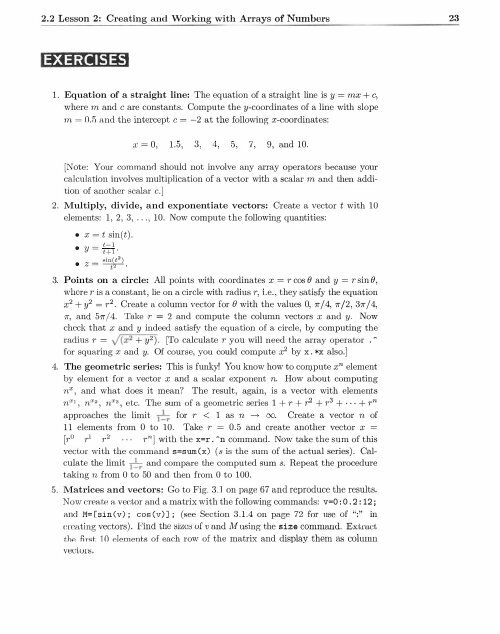You also want an ePaper? Increase the reach of your titles
YUMPU automatically turns print PDFs into web optimized ePapers that Google loves.
2.2 Lesson 2: Creating and Working with Arrays of Numbers<br />
23<br />
EXERCISES<br />
1. Equation of a straight line: The equation of a straight line is y = mx + c,<br />
where m and c are constants. Compute the y-coordinates of a line with slope<br />
m = 0.5 and the intercept c = -2 at the following x-coordinates:<br />
x = 0, 1.5, 3, 4, 5, 7, 9, and 10.<br />
[Note: Your command should not involve any array operators because your<br />
calcul11.tion involves multiplication of a vector with a scalar m and then addition<br />
of another scalar c.]<br />
2. Multiply, divide, and exponentiate vectors: Create a vector t with 10<br />
elements: 1, 2, 3, ... , 10. Now compute the following quantities:<br />
• x = t sin(t) .<br />
t-1<br />
•<br />
y = t+l .<br />
sin(t2 )<br />
• z = ·<br />
3. Points on a circle: All points with coordinates X = r cos e and y = r sin e'<br />
where r is a constant , lie on a circle with radius r, i.e., they satisfy the equation<br />
x2 + y2 = r2. Create a column vector for e with the values 0, 7r I 4, 7r12, 37r I 4,<br />
1r, and 57rl4. Take r = 2 and compute the column vectors x and y. Now<br />
check that x and y indeed satisfy the equation of a circle, <strong>by</strong> computing the<br />
radius r = J(x2 + y2). [To calculate r you will need the array operator . -<br />
for squaring x and y. Of course, you could compute x2 <strong>by</strong> x. *X also.]<br />
4. The geometric series: This is funky! You know how to compute xn element<br />
<strong>by</strong> element for a vector x and a scalar exponent n. How about computing<br />
n x , and what does it mean? The result, again, is a vector with elements<br />
n x , , n x 2 , n x3 , etc. The sum of a geometric series 1 + r + r2 + r3 + · · · + rn<br />
approaches the limit l<br />
r<br />
for r < 1 as n -+ oo. Create a vector n of<br />
11 elements from 0 to 10. Take r = 0.5 and create another vector x =<br />
[r0 r1 r2 rn] with the x=r . -n command. Now take the sum of this<br />
vector with the command s=sum(x) (s is the sum of the actual series). Calculate<br />
the limit l<br />
r<br />
and compare the computed sum s. Repeat the procedure<br />
taking n from 0 to 50 and then from 0 to 100.<br />
5. Matrices and vectors: Go to Fig. 3.1 on page 67 and reproduce the results.<br />
Now create a vector and a matrix with the following commands: v=O : 0 . 2: 12;<br />
and M= [sin(v) ; cos (v)] ; (see Section 3.1.4 on page 72 for use of " :" in<br />
creating vectors). Find the sizes uf ·u and Musing the size command. ExlmcL<br />
thP. Ar.qf: 10 Alementf; of each row of the matrix and display them as wlumn<br />
vedvrs.



